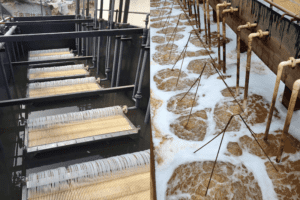Last Updated on July 6, 2022 by Kevin Chen
Membrane Bioreactors (MBRs) have emerged as a powerful tool for wastewater treatment due to their ability to efficiently convert organic matter into biogas and hydrate sludge for easy disposal. Membrane bioreactors are also known for their low maintenance requirements and ability to operate in a closed-loop system, which makes them an ideal option for land-based wastewater treatment plants. In this article, we’ll compare the flat sheet MBR and the hollow fiber MBR membrane.
| Comparison | Flat Sheet MBR | Hollow Fiber MBR |
|---|---|---|
| Typical Brand | Toray, Kubota, Sperta | GE, Mitsubishi, Sperta |
| Usage rate | Around 15% | Around 85% |
| Material | PVDF | PVDF |
| MBR membranes for filtering sewage treatment and reuse require materials with strong oxidation resistance, so PVDF's superior oxidation resistance than other materials (such as PE) determines that PVDF materials are the mainstream materials for MBR membranes. | ||
| Flux | 10L/m²/h ~ 40L/m²/h | 10L/m²/h ~ 40L/m²/h |
| Pre-processing requirements | No Special Requires | Requires removal of as much hair as possible into the water |
| Hollow fibers have the risk of being tangled by hair, so care must be taken when handling domestic wastewater, including hair or thread-like fibers | ||
| Packing density | Taking Toray TMR140-100s as an example, excluding the membrane separation volume, the area of 140m2 membrane needs to occupy 2.756 m3 | Take Dow FLEXELL as an example, calculate the membrane separation volume, 80m2 membrane surface Product needs to occupy 0.7056m3 |
| The filling density of hollow fiber MBR is more than twice that of flat MBR, saving land occupation and biochemical space | ||
| Pollution recovery Method | Air scrubbing, chemical cleaning | Backwash, air scrub, chemically enhanced backwash, chemical cleaning |
| Can not backwash is the biggest defect of flat membranes. Backwashing is the most ideal pollution recovery method for the membrane industry (including MBR, microfiltration, ultrafiltration). Failure to backwash to restore membrane pollution will shorten the chemical cleaning cycle of the membrane. The main reason for the roll-out ultrafiltration to completely withdraw from the ultrafiltration market is that it cannot be backwashed. | ||
| Operational risk | Diaphragm risk of breakage, such as "fat belly" phenomenon | Risk of fiber broken |
| The flat membrane is easy to rupture. When the machine is taken out during shutdown, the water inside the membrane bag will be collected by the gravity under the membrane bag and the membrane will be broken. The risk of hollow fibers is that if the strength of the membrane filament is insufficient, filament breakage may occur, but with the breakthrough of membrane-forming technology, especially the thermal membrane process (TIP process), the strength of membrane filaments has increased It is more than ten times, which basically eliminates the filament breakage phenomenon of the hollow fiber membrane during operation. | ||
| Self-healing | No self-healing function | Has self-healing function |
| After the flat membrane is damaged, the entire membrane must be replaced; if the hollow fiber is broken, the small flow path of the hollow fiber will be blocked by sludge, which can repair itself without replacing the membrane element. | ||
| Component structure | Large modular | Integrated configuration using single element |
| Overhaul and maintenance need to set up large lifting equipment, lift out the module | When maintenance and repair is required, a single person can remove it without tools. Easy maintenance | |
| Energy consumption | The air-water ratio is generally above 30: 1. Air-to-water ratio, air intake or water intake consumes energy, power equipment | Using pulse gas, the gas-water ratio is generally around 3: 1 ~ 5: 1 |
| Large gas consumption during operation | Low gas consumption during operation, low energy consumption | |
| Chemical Wash | Chemical immersion combined with manual scrubbing | Chemical immersion |
| Cleaning is complicated and requires a lot of labor | Simple cleaning, can be done automatically and can be operated by one person | |
Post Views: 1,017








